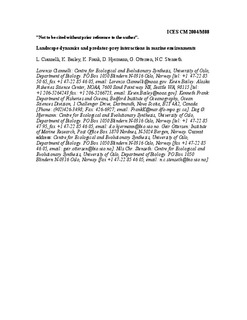Landscape dynamics and predator-prey interactions in marine environments
Ciannelli, Lorenzo; Bailey, Kevin; Frank, Kenneth T.; Hjermann, Dag Ø.; Ottersen, Geir; Stenseth, Nils Christian
Abstract
In several sub-arctic marine ecosystems of the North Atlantic capelin are the primary
prey item for cod, and the trophic interaction between capelin and cod is a central
energetic pathway. However, in the North Pacific capelin are, in spite of their high
abundance, barely represented in the diet of cod. In the Bering Sea this uniquely weak
trophic link is the consequence of oceanic landscape features (e.g., bathymetry,
hydrography, currents, and presence of suitable spawning areas) that generate a barrier
between the centers of distribution of cod and capelin. Climate forcing influences labile
features of this distributional barrier (i.e., hydrography) and may result in greater/lower
predator-prey overlap through the opening of thermal gateways and corridors. In the
current study we compare the results from the Bering Sea with those from the Barents
Sea, where cod are strongly dependent on capelin as prey. Through this comparative
analysis we wish to illustrate the importance that oceanic landscape and climate forcing
have on the spatial overlap and trophic interactions between predator and prey. Spatial
considerations are seldom accounted for in population dynamics models, even though the
mechanisms that promote overlap variability can indirectly have profound effects on
population demographic rates. In that regard we believe that our analysis is relevant to
better comprehend the mechanisms leading to regime shift of marine forage population
dynamics in the presence of climate forcing.
Publisher
ICESSeries
ICES CM documents2004/M:08
